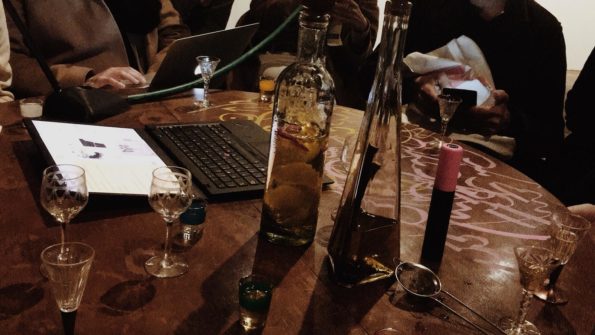Search
To search for an exact match, type the word or phrase you want in quotation marks.
A*DESK has been offering since 2002 contents about criticism and contemporary art. A*DESK has become consolidated thanks to all those who have believed in the project, all those who have followed us, debating, participating and collaborating. Many people have collaborated with A*DESK, and continue to do so. Their efforts, knowledge and belief in the project are what make it grow internationally. At A*DESK we have also generated work for over one hundred professionals in culture, from small collaborations with reviews and classes, to more prolonged and intense collaborations.
At A*DESK we believe in the need for free and universal access to culture and knowledge. We want to carry on being independent, remaining open to more ideas and opinions. If you believe in A*DESK, we need your backing to be able to continue. You can now participate in the project by supporting it. You can choose how much you want to contribute to the project.
You can decide how much you want to bring to the project.

The concept of scene comes from skene, that from the Greek could be translated for something, like, a shack: a fragile building that allowed the priests to change apparels for different roles in the Dionysian rituals. In the primitive theatre, the scene, as a scenic space, was the place where actors changed their costumes or masks. A place beyond the limit of the stage.
Paradoxically, as an effect of the metonymy, the scene developed as the space for the performance, a dimensional drawing of the reality in which some ideas are projected and once separated, can be understood to give meaning to the ensemble. A scene is a drama, a dramatization. It is a selection to elaborate a speech.
What is not seen in the scene, its external space, is the obscene space: the place where obscenities are hidden. The obscene would then be everything that makes the scene stand from the invisibility, everything that is not present in the context of performance, but without it the rest would be meaningless. For example, all the other jobs, works, artists, agents, producers, interferences, documents, telephone calls, discussions, dossiers, budgets or interviews that remained outside of the scene frame.
In January, La Capella started the celebration of its 25 anniversary in hand with five superintendents that propose doing a journey through Les Escenes that this space has generated, understanding La Capella not as a stage but in the way of that original skene; as a generative place of scenes, of successive scenes, parallels or constituent.
These scenes are shown as a succession of exhibits that bracket the works of the artists that have been or that could have been in this space. Six scenes through the works, in different combinations –stages- of relations between pieces or passages of the pieces are shown. A bet that brings up some questions, such as if the scenes are the works or the people, or the obscenities. Or if the scenes are the communities, or if the community is a scene. This latter seems too problematic as to be hold on.
Apparently, we have never been part of these scenes that La Capella has fathered. Although maybe, since we have written about exhibits. Or perhaps for the simple proximity of having been able to follow the processes of the ones that have been present. Thereby, we could stand that we have collaborated with some things that have ended up there at one time or another. Or simply because we have piled up as meandered bodies in inaugurations, performances and other events that have taken place, in and outside the town. Oblique and from the surface. A surface that works as a kind of membrane that goes through and understands a dogma in constant controversy. Something that is not but it is there. We are part of the obscene of the scene. Likewise, as desiring bodies, we have walked again through this gloomy space occupied by an impossible exhibition determined to open the possibilities to think how it relates to us, and to the others and to the hereafter.
We promised ourselves not to talk in this text about any work in particular. A previous convention to the writing that cracks now after attending to the mediated reading The Sleepwalker by Ariadna Guiteras. This reading it is carried out around a small circumstantial community of people, all women that day, reunited around a table, and referred to a previous scene, way before the 25 years of existence of the visual arts programme. She referred to the scene of the Catalan spiritualism that strongly existed in the mid to the late 19thcentury, and that was closely linked to the anarchist movements of the time. During the reading, Ariadna’s voice took the voices, the texts, the words of other times back here, to a table located in the centre of La Capella The present community connected like this with other communities that made themselves present through technologies like the voice, the Wi-Fi, the marker, the screen or the moonshine. What is the relation between the gesture of thinking the porous bodies pierced by the voices of some mediums that came here two thousand years ago and the one of calling on the origin of the scenographic and cultural project? And more specifically with the one of generating a story that makes it understandable?
By extension, a scene is understood as an environment or a sphere, an ensemble of circumstances in which a situation takes place. And we often have the temptation of reviewing these environments to understand if they are special and therefore producers of something specific, something like a “Catalan art”, “from Barcelona” or even “emerging”, or not. The proof is that every year there is a celebratory event of the context that beyond the reviewing looks for recognizing the community in its environment or perhaps through the representation, generating community. And therefore, an outside of the community. Some examples would be “Raw Material” at Barcelona Contemporary Art Centre Fabra i Coats from last year, or “A question of paradigm” that took place in 2011 in the same Chapel, or “Querer parecer noche” (To want to seem night) some months ago at the CA2M in Móstoles. Even the new reordering of the collection of MACBA we could say that its’ intention is to think in relation to a certain context and to a certain story of the localized history. At Fabra i Coats, instead of “scene” the concept of local “ecosystem” of the visual arts was proposed, and in Móstoles were talking precisely about the “disappearance of the question” and of the will of escaping to the continuity towards the eccentricity, placing oneself – at least since the curatorial narrative- in the darkness of the night. In the obscene, perhaps?
Placing oneself in the obscene implies to face a challenge: to turn the trap around and demolish the cardboard. Break the proscenium and bore into the fourth wall. Shatter the bundle that covers the scene or cross out what it is written on the paper. Perform for the first time what has already been shown. Celebrate what has already been seen. Expose. Expose what has never been exposed. Call the voices that are not usually heard. Dispossess the scene: take it out of those own places that isolate it, codify it and neutralize it to be able to entangle it back to the reality in which it is enrolled. Go beyond the tyranny of the visibility and of the same idea of the scene as something to defend.
If “talking about culture has always been against the culture as long as it already contains the recruitment, cataloguing and the classification that gives the culture to the administration”[1], talking about “the scene” could turn against the scene in which it refers? A scene, as a sphere, defines first of all a space for visibility. Establishes which personal names and which proposals are or count. That is to say that it determines who are the valid interlocutors through profiles, expectations or selection criteria that allow access to visibility. But what happens with what is not seen in the scene? What to do with what does not fit in it or make into flee? Rip the scene is not juxtaposing differences but assuming that not everything is seen and that not all of whom you count with can be counted. That it is important to be in the scene but also not being there. That it is important to win calls but even more not to win them. Rip the scene implies to renounce to the specification of the profiles, the generations, the quotes, the places or the geographies because the imposed limits not only do not realize the permeable power of what occurs but mutilate it and asphyxiate it. Being placed in the obscene consists on opening oneself to the several possible scenes that enter and leave the scene. Because not everything can be seen, but we do not want to see it either.
(Photograph: Marianne Blanco)
[1]Adorno and Horkheimer, The Dialectic of Enlightenment

Caterina Almirall has only just been born into this world, but has lived in others, in similar parallel worlds, both liquid and solid. From each she has learnt something, and forgotten something else. Learning to unlearn. In all of these worlds she has been caught up in a web that interweaves everything, some call it ’art’…Entwining, unravelling, weaving and destroying this labyrinth has been her occupation in each one of these planets, and she fears that it will be the same in each of the ones to come.

Carolina Jiménez is a curator and researcher.
"A desk is a dangerous place from which to watch the world" (John Le Carré)